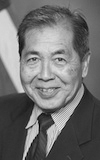(Editor’s Note: The following, lightly edited, was originally posted by the author on his Facebook feed and is reprinted with his permission.)

Ron Wakabayashi
Hate crime apprehension, prosecutions and convictions are difficult and rare. At a federal level, establishing nexus is very rare. What the justice system requires to label an event a hate crime is a different animal from how the community defines and uses the term. It will create misunderstanding.
“Hate crime” is not itself a crime. It is a statutory enhancement that adds penalties if bias motive can be proven. Because that requires having “evidence” of motive, of being able to document what’s in somebody’s head, it is hard to evidence. This challenge is over and above establishing federal nexus.
The legal bar is really complex. While I know most law enforcement is responsive to major hate incidents, policing and prosecution have limitations.
The community sense of hate incidents is different and more practical. It’s having a strong sense that an incident has/had a bias motive. Sometimes, that is situational and circumstantial. It’s our basic survival mechanisms recognizing a threat. We can feel it. We can suspect it. But that doesn’t reach the legal standard. What it does is cause anxiety and fear of an elevated sense of risk of victimization and vulnerability.
With reports that the number of reported hate crimes against Asians increasing by more than a factor of 10 during the past year and a steady stream of media reports of serious assaults, there is deep concern.
Understand that the API community had anxiety that the hate crime rate would rise. We could hear the inciting rhetoric coming from the Trump administration. Our antenna was up. Community organizations began to monitor and collect suspected incidents more than a year ago.
Before I retired almost a year ago, our regional office of the USDOJ Community Relations Service recorded this happening, and we began alerting cases. It took a year before it broke into public attention.
This is not our first experience with anti-Asian backlash. It has had a presence throughout our history in the United States. In the 1980s, concurrent with the period of the campaign of Japanese Americans to seek redress for the wartime incarceration, the growing trade conflict with Japan was the driver for a period of increased incidents.
Before the Vincent Chin murder, JACL chapters submitted more than 300 media-reported incidents. We annotated those submissions and published a report that Rep. Norman Mineta distributed to Congress.
From that flowed the formation of a coalition of the JACL, Chinese for Affirmative Action and the Asian Law Caucus organized a response under the coalition name of “Break the Silence.” I recently sent Helen Zia, a journalist and Asian American activist, buttons from that era. She’s working on a television capture of Vincent’s murder.
Later in my career, when I served as the director of the Los Angeles County Human Relations Commission, I was on site at a local Japanese cultural center that had been vandalized with racial graffiti. I recall overhearing a Sansei mother, speaking to her 6-year-old daughter wearing a basketball uniform, saying, “Young Lady, you can go to practice tonight, but don’t you dare come outside. You stay inside with the coach until your father comes.” The guidance was for the little girl’s safety. The message was, “BE AFRAID!”
So now, we have community response. We have escort services for our elders by younger members of the community. We have outright security patrols. We have distribution of handheld sound alarms. We have rallies and protests. Hell, I’m anxious in my retirement as a Ji-san taking daily walks. And, I am saddened by the anti-Black and anti-Asian tensions agitated in another layer of reaction.
I have written about how the approach of reopening schools presents another period of anxiety. Will we have a spike in bullying and incidents that parallel what Arab, Muslim, Sikhs and others experienced after 9/11? Most of the worst incidents, murders, involved Sikhs. Mistaken identity tied to turbans.
Will more opportunities for incidents exist because lockdowns will decline?
The work of Stop AAPI Hate is appreciated as are other initiatives launched to protect the community. Women and elderly are overrepresented among the victims. There is a streak of extreme violence in the physical assaults reported. Immolation, a face slashed with a box cutter, body slams.
No magic bullet exists. I know there is a growing response. USDOJ incoming leadership is in active preparation. The White House has issued one executive order already to address the problem. Community response has been very strong. Lean forward and stay tuned. More to come.
Ron Wakabayashi is a former JACL national director.



